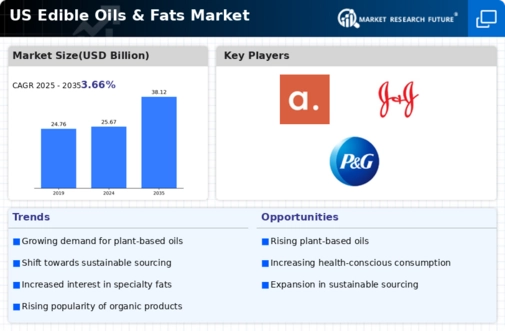Expansion of Food Service Sector
The expansion of the food service sector is significantly impacting the edible oils-fats market. As restaurants and food chains proliferate, the demand for various cooking oils is on the rise. This sector is projected to grow at a rate of 5% annually, leading to increased consumption of oils for frying, baking, and food preparation. Additionally, food service establishments are increasingly opting for oils that align with health trends, such as non-GMO and organic options. This shift not only boosts the sales volume in the edible oils-fats market but also encourages manufacturers to innovate and diversify their product lines to meet the evolving needs of the food service industry.
Rising Popularity of Ethnic Cuisines
The growing interest in diverse culinary experiences is driving the demand for various types of oils in the edible oils-fats market. As consumers explore ethnic cuisines, there is an increased need for oils that are integral to these cooking styles, such as sesame oil, coconut oil, and olive oil. This trend has led to a projected growth of 10% in the market for specialty oils. Retailers are expanding their offerings to include a wider range of oils, catering to the evolving tastes of consumers. This diversification not only enhances the product portfolio but also contributes to the overall growth of the edible oils-fats market.
Growing Demand for Sustainable Products
The edible oils-fats market is witnessing a notable shift towards sustainability driven by increasing consumer awareness regarding environmental issues. As consumers become more conscious of their purchasing decisions, they are gravitating towards products that are sustainably sourced. This trend is reflected in the rising demand for oils derived from organic farming practices, which has seen a growth of approximately 15% in recent years. Additionally, brands that emphasize eco-friendly packaging and production methods are gaining traction, further influencing the edible oils-fats market. Companies are now investing in sustainable supply chains to meet this demand, which could potentially reshape the competitive landscape of the industry.
Technological Advancements in Oil Extraction
Innovations in extraction technologies are significantly impacting the edible oils-fats market. Techniques such as cold pressing and supercritical fluid extraction are becoming more prevalent, allowing for higher yields and better quality oils. These advancements not only enhance the nutritional profile of oils but also improve their shelf life. The market has seen a surge in the adoption of these technologies, with an estimated increase of 20% in production efficiency. As manufacturers continue to invest in research and development, the edible oils-fats market is likely to benefit from improved product offerings and enhanced consumer satisfaction.
Health Consciousness and Nutritional Awareness
The rising health consciousness among consumers is a pivotal driver for the edible oils-fats market. As individuals become more informed about the nutritional aspects of their diets, there is a marked shift towards oils that are perceived as healthier options. This includes oils high in unsaturated fats and low in trans fats. Recent surveys indicate that nearly 60% of consumers actively seek out healthier oil alternatives, which has led to a surge in the sales of oils such as avocado and olive oil. This trend is likely to continue influencing product development and marketing strategies within the edible oils-fats market.














Leave a Comment